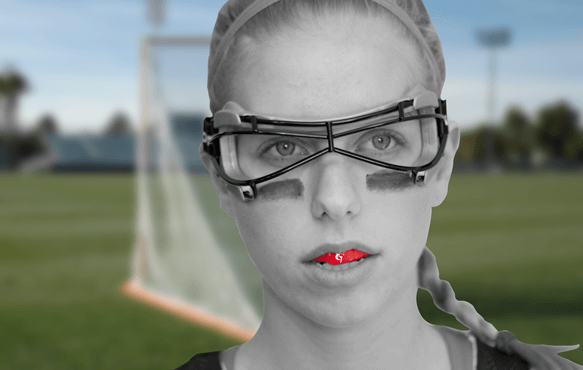What You Absolutely Need To Know About NATA’s Mouthguard Recommendations

As we’ve stated in this space many times, athletes have a 33-56% chance of receiving an orofacial injury — an injury to the mouth or face — during their playing career. That’s why the American Dental Association and the Academy for Sports Dentistry recommend a professionally-made, properly-fitted custom mouthguard for all contact and collision sports.
And now another leading organization is furthering that recommendation. The National Athletic Trainers’ Association (NATA) recently released a new position statement on dental injuries, including recommendations on emergency planning, dental injury classification, and education on both mouthguard effectiveness and mouthguard care.
While NATA — which represents and supports more than 44,000 members of the athletic training profession — focuses primarily on athletic trainers, their recommendations for mouthguard effectiveness, material, fabrication and care are great for every athlete, coach and parent to follow as well.
So, what does their statement entail? We break down a few of the key and relevant points:
Mouthguard Effectiveness
According to NATA’s statement, mouthguards are consistently effective at protecting against orofacial injuries and athletes are encouraged to wear “properly fitted mouthguards during sports activities with an increased risk of orofacial injury.”
That means a custom-made mouthguard that is designed to fit the individual mouth structure of each athlete. Everyone’s mouth is different and that means mouthguards are only effective when they fit properly.
Of course, mouthguards only work if they are worn too. From NATA: “The athlete’s perceived comfort with the mouthguard is critical and of paramount importance for compliance. Noncompliance has been related to bulkiness, stability, hardness, dyspnea, speaking difficulty, oral dryness, and nausea.”
The biggest and most frequent complaint that athletes have about their mouthguards is that they are bulky and uncomfortable, which restricts breathing and muddles speech. But that’s only because they are wearing the wrong mouthguards.
When a mouthguard is cut correctly, there isn’t any unnecessary or unwanted material in places it shouldn’t be. For example, a mouthguard shouldn’t have any material in the soft palate area — the fleshy, flexible part toward the back of the roof of the mouth. Any protective material in the soft palate area doesn’t actually provide protection from injury; it only adds to the weight and discomfort of the mouthguard.
A proper cut also streamlines your mouthguard as much as possible, by adjusting the thickness in specific areas. It’s important to maintain proper thickness for protection, but anything beyond that could cause uncomfortable gagging.
Mouthguard Material, Fabrication And Care
According to NATA’s statement, athletic trainers should be familiar with current mouthguard designs, the materials used to make them and the variables that go into that material.
The statement identifies key considerations for a properly fitted mouthguard, including: material that meets approval of the US Food and Drug Administration, fabricated over a stone model from an impression and adequate thickness in all areas. According to NATA, most mouthguards worn by athletes during sports activities are the boil-and-bite types, which do not meet the definition of “properly fitted.”
While there are no national standards for protection, NATA recommends that proper protection starts with a minimum of 4 mm of material in the important impact zones — the areas in front of your teeth and under your molars. That means there isn’t bulky material where protection isn’t needed. However, these zones change from sport to sport.
For contact sports like football and ice hockey, frontal impact is guarded by the facemask or shield, so your mouthguard may have a thinner frontal profile, but feature more protection under the molars. For combat sports like MMA or boxing that take deliberate and frequent impacts to the mouth and face, your mouthguard will need a more protective frontal profile.
As for the principles of general mouthguard material, NATA suggests a material that is:
- Easy to manipulate
- Resistant to damage from hot water, low pH and water absorption
- Resistant to fracture under sudden impact
- Sufficient elastic modulus to reduce stress beneath material at point of impact, rigidity to distribute forces over a large surface area of the teeth, and toughness to resist cutting by biting
- Ability to withstand normal cleaning compounds
- Tasteless and odorless
While NATA recommends that mouthguards are cleansed with a mild antimicrobial agent and rinsed thoroughly in water both before and after use, a denture cleaner or effervescent cleaner works best.
They also suggest that athletes should store mouthguards in a clean, rigid and ventilated plastic container, and they should not be exposed to prolonged direct sunlight or sources of heat. Athletes should also examine their mouthguard daily for fit and for any damage.
From mouthguard effectiveness and care to the design and materials used, the National Association of Athletic Trainers makes very important recommendations for mouthguards. What do you think of NATA’s statement and advice? Let us know your thoughts in the comments below.
Learn Why NATA Recommends Custom Fit




 As we’ve stated in this space many times, athletes have a 33-56% chance of receiving an orofacial injury — an injury to the mouth or face — during their playing career. That’s why the American Dental Association and the Academy for Sports Dentistry recommend a professionally-made, properly-fitted custom mouthguard for all contact and collision sports.
As we’ve stated in this space many times, athletes have a 33-56% chance of receiving an orofacial injury — an injury to the mouth or face — during their playing career. That’s why the American Dental Association and the Academy for Sports Dentistry recommend a professionally-made, properly-fitted custom mouthguard for all contact and collision sports. 

